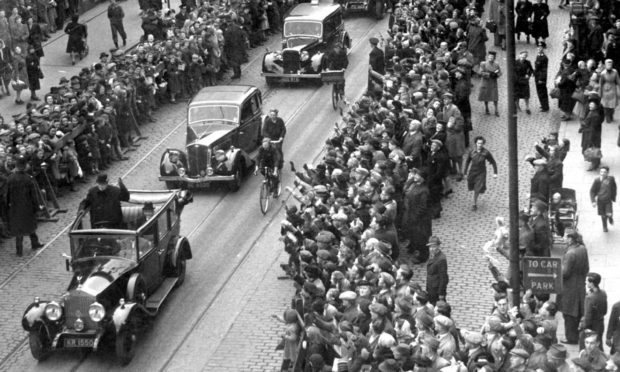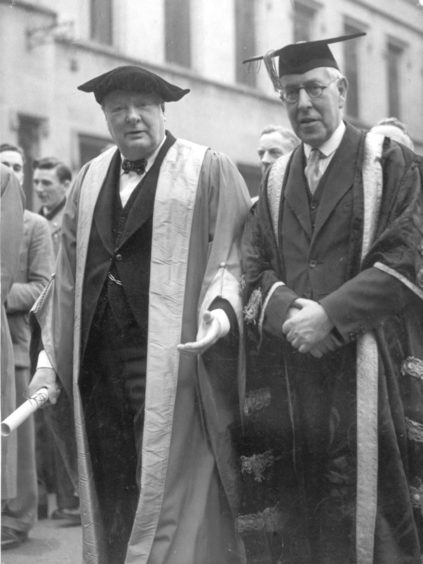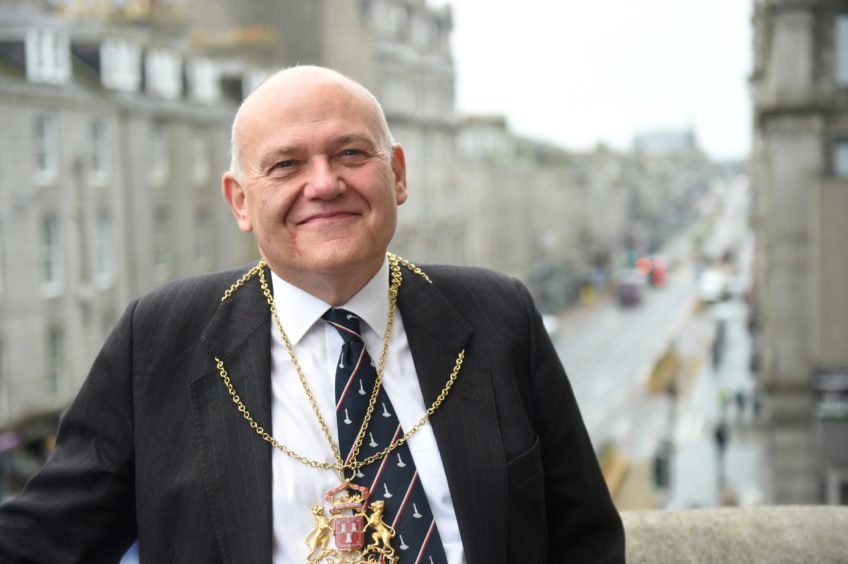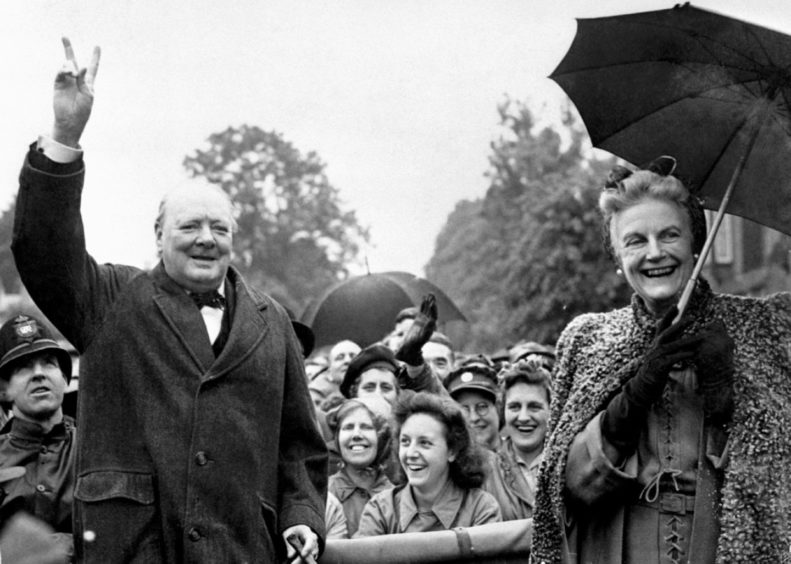He was one of the most famous figures in the history of the 20th century.
And she was a refugee from the horrors of Nazism who arrived in the north-east of Scotland just before the start of the Second World War.
Yet, while there might seem to be little in common between Sir Winston Churchill and Ernestine Young, they met in unlikely circumstances when the wartime leader received the Freedom of Aberdeen in 1946.
Churchill had plenty of connections with Dundee, where he had served as an MP for many years, but didn’t make many official visits to the Granite City.
He was welcomed by Ernestine, a member of the Kindertransport scheme which helped as many as 10,000 children to escape from Adolf Hitler’s reign of terror in parts of Europe before they were relocated throughout Britain.
Precious few arrived in such grand fashion as the little girl called Ernie by her family and her friends when her train pulled into Aberdeen Railway Station in January 1939.
A child’s journey from Austria to Aberdeen
Born Ernestine Friedlander in 1929, she was just nine years old when her mother, Hedwig, decided that Vienna was too dangerous an environment and contacted a refugee agency in Edinburgh.
The duo had to wait several months before learning any news about gaining the necessary permits and documentation, but eventually she bade farewell to her mum, joined hundreds of other children who were being evacuated from Austria, and embarked on a journey which took her to Aberdeen on January 11.
She was met at the train station by a chauffeur-driven Rolls-Royce and was subsequently adopted by Sir Thomas and Lady Jaffrey, one of the region’s richest couples who lived in a sprawling 16-acre estate.
As she said later, it was the start of “very different life”, but she was always grateful for the philanthropy of the Jaffreys who were staunch supporters of Kindertransport.
It meant she could grow up in a relatively safe and secure place, a world removed from the treatment of Jews in her homeland, many of who were sent to concentration camps.
‘The world changed during Kindertransport’
Barney Crockett, the Lord Provost of Aberdeen, said the city’s incorporated trades had been keen advocates of the scheme to assist youngsters in travelling to Britain.
He added: “This was a very turbulent time in world history and Aberdeen was among the cities which recognised the urgent need to help those who were struggling across Europe, even before the war started in the second half of 1939.
“There were many youngsters who came here and settled down, but few had the sort of experiences as Ernestine who was taken in by the Jaffreys.
“They were well-known people in the city and Sir Thomas [who lived from 1855 to 1953] was involved in many philanthropic centuries, including donating to hospital bodies and arts groups and playing a prominent role at Aberdeen University.
“When Ernestine came to Aberdeen, she could hardly have imagined that, just a few years later, she would not only be meeting Sir Winston Churchill, but saying grace for him at the breakfast table when he stayed with the Jaffreys in 1946.
“It happened a long time ago, but we are still finding out just how many children and young people were helped by the Kindertransport scheme which saved so many lives and helped so many Austrian and German Jews being sent to concentration camps.”
Ernestine, who died in 2009 aged 80, always considered herself to be one of the lucky ones of her generation and she was determined to make the most of her escape.
After continuing her education during the war, encouraged by the Jaffreys, she went to Aberdeen University and graduated with an MA in modern languages.
And she remained in contact with her mother, until the latter’s death in 1954.
Churchill’s visit to Aberdeen drew large crowds
Although Churchill had lost the Khaki election to the Labour Party in 1945, he was still an enormously popular figure who commanded crowds wherever he travelled.
He arrived in the Granite City on April 27 1946 and, after he and his wife, Clementine, and their associates left the railway station, they visited the Jaffreys at Edgehill, where the former PM planted a tree in the garden of the palatial property.
He and his wife had breakfast with their hosts and it was here that the teenager Ernestine, a bright and accomplished speaker, said grace in front of the distinguished party on what was one of the grandest occasions in the post-war period for the city.
This was followed by a motorcade along Union Street, which was packed with members of the public in scenes recorded by an old Pathe newsreel, as the prelude to a reception at the Music Hall where Churchill was officially given the Freedom of the City.
Thereafter, as the Aberdeen Journal noted: “The whole of Union Street was filled with cheering crowds and the sound of bagpipes as the motorcade slowly advanced.
“It was a joyous occasion for the local residents who had waited to acclaim Sir Winston and there were many cries from well-wishers as he waved to the crowds.”
Sir Thomas Jaffrey is Aberdeen’s ‘forgotten’ hero
Aberdeen University recently celebrated the 100th anniversary of the Jaffrey Chair in Political Economy, which was set up following an endowment by Sir Thomas, who was one of Aberdeen’s most respected businessmen and philanthropists.
The university’s SIRE Professor of Economics, Keith Bender, is writing a biography of the man who looked after Ernestine Friedlander all these years ago and believes he deserves more recognition for his many accomplishments during his long life.
He said: “Thomas Jaffrey is a forgotten figure in Aberdeen’s past, which is both surprising and unfortunate.
“A banker by trade, Jaffrey led a long and productive life, serving the city he loved. As well as being a leading businessman, he gave back a great deal to his hometown, including the endowment of the Chair in 1920 at a cost of £20,000.
“Later, he donated £25,000 to the Aberdeen Joint Hospital Fund for a Hospital for Sick Children and a Maternity Hospital in 1927.”
The link between Jaffrey and Aberdeen’s famous leopards
Born on February 6 1855, Thomas Jaffrey was raised in Aberdeen and was first employed with the North of Scotland Bank in 1877. Soon afterwards, he moved to the up-and-coming Aberdeen Savings Bank, ascending to the post of actuary of the bank in 1892, a position he held for 37 years until his retirement.
During this time, he was renowned for modernising and growing financial operations at the ASB, making it the fifth largest savings bank in Britain.
In 1896, he oversaw the building of a new headquarters on Union Terrace, designed by William Kelly, the architect who designed the leopards on Union Bridge.
He embraced art, culture and philanthropy
Sir Thomas Jaffrey was also generous with his time, serving as a committee member and then chairman of the Aberdeen Art Gallery Committee from 1928 to 1951, during which time he oversaw both an expansion of the building and the collection.
His contributions were recognised locally with the receipt of an honorary LLD from the university in 1922, and the Freedom of the City in 1928, and nationally with a knighthood in 1920 and a baronet in 1931.
He also met a number of political dignitaries when they journeyed to Aberdeen in the first half of the 20th century, including US ambassador Joseph Kennedy – the father of future President John F Kennedy – and he entertained Prime Ministers David Lloyd George and Winston Churchill during their visits to Aberdeen.
But it appears he was as proud of his involvement in Kindertransport as anything else.




